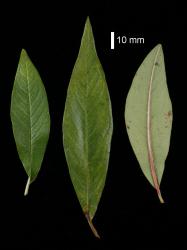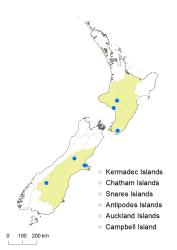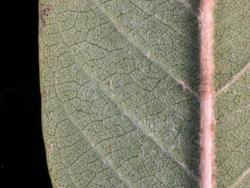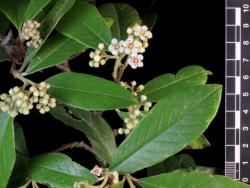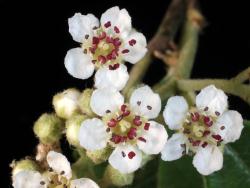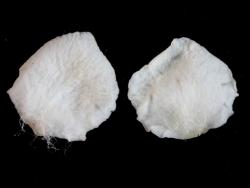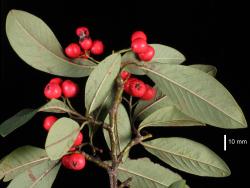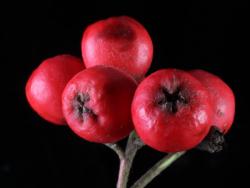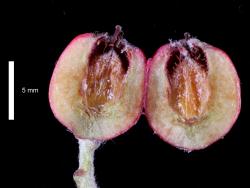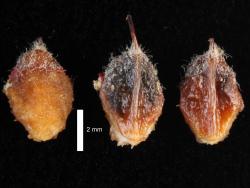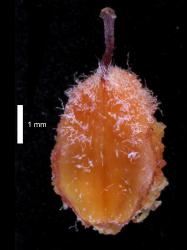Shrub or small tree, 2.5–7 m tall, larger plants with multiple trunks, erect, evergreen (most leaves retained by September), branching tending 2-ranked on reproductive branches. Branchlets dark purple, glossy, with peeling cuticle and lenticels. Stipules 2.7–3.1 mm long, red, hairs dense. Leaves narrowly elliptical or slightly narrowly ovate, plane, (50)90–120(125) mm long, lamina 90–110(125) mm long, 23–40 mm wide, veins in 5–13 pairs, lamina 230–270 µm thick, petiole 8–11(14) mm long with dense, straight, but fine hairs; midvein and lateral veins impressed above, midvein and lateral veins projecting below, slightly rugose due to convexity between the side veins, upper surface moderate yellowish-green (RHS138A), semi-glossy to glossy, hairs on upper surface of young leaves very sparse, mostly in the midvein groove, old leaves glabrous on upper surface; margins slightly recurved or plane when dried, plane when fresh, glabrous or rarely densely hairy; undersurface glaucous, moderately densely hairy when young, hairs sparse when old and usually confined to the midvein and lateral veins; base of lamina cuneate; apex acute with straight apiculus, rarely bent downwards.
Inflorescence a compound corymb of 29–50 flowers, c. 35 fruit, rachis hairs dense, pale yellow. Pedicels 0.5–2.0 mm long, hairs dense. Flowers 7.5 mm diameter. Hypanthium with hairs dense; sepals broadly triangular, 0.6–1.0 mm tall, 1.6–2.6 mm wide. Petals spreading, white, 2.6–2.9 mm long, 2.6–2.8 mm wide, clawed, glabrous, margins entire or irregular but not torn. Stamens 17–21, filaments 2.8–3.0 mm long, white, anthers purple, 0.6–0.7 mm long; styles 2–3, 1.4–2.0 mm long. Fruit vivid reddish-orange to vivid red (RHS 33A–45A), obovoid, 10.0–10.7 mm long, 10.0–11.2 mm wide, hairs on mature fruit absent, navel closed; pyrenes 2–3, 3.6–4.0 mm long, 2.8–3.1 mm wide, hairs sparse, apex acute, style nearly always attached at apex, rarely up to 0.5 mm below apex.
A large-leaved shrub or small tree (leaf lamina [50]90–125 mm long, 23–40 mm wide) with dark purple erect to arching branchlets. The leaves are narrowly elliptical, semi-glossy and dark green and very sparsely hairy on the upper surface. The midvein is impressed and the lateral veins lightly impressed, making the leaf slightly rugose. The underside of the leaf lamina is glaucous, moderately densely tomentose, the tomentum becoming sparse and usually confined to the midvein on old leaves, the underside midvein pink-tinted, the tinting becoming stronger in autumn leaves. The flowers have spreading white, glabrous petals. The fruit have 2–3 pyrenes in about equal numbers, which have the style attached at the apex. In New Zealand, cultivars appear to be all erect shrubs, but prostrate cultivars are grown overseas.
Most similar to the parent C. salicifolius, which appears to be rarely grown in N.Z., in contrast to Europe, where the parent appears to be much more common than the hybrid (Dickoré & Kasperek 2010). Cotoneaster ×watereri and C. salicifolius are distinguished by leaf size, how rugose the leaves are, and fruit diameter. However, the two seem to intergrade with no reliable differences, particularly as the hybrid appears to be very variable in leaf size. Identification needs to be done using the combination of characters mentioned above.
Most C. ×watereri have a leaf lamina 90–135 mm long × 23–40 mm wide, are weakly or not rugose, and have a dry but uncompressed fruit diameter of 5.7–8.0 mm. Cotoneaster salicifolius has a leaf lamina 60–85 mm long, 18–22 mm wide, the leaves are fairly strongly rugose, and have a dry uncompressed fruit diameter 4.2–7.0 mm and a fresh diameter of 10–11 mm.
Plants that have a leaf lamina more than 100 mm long are certainly C. ×watereri, but C. ×watereri can have small leaves in the 60–90 mm range. The only way of deciding the identity of such small-leaved plants seems to be the degree of rugosity of the leaf (stronger in C. salicifolius).
Volcanic Plateau (Raetihi, 2006–2014), Southern North Island (Whanganui 2003; Wairarapa, 2000), Canterbury (Port Hills, 1998–2016; Craigieburn, 1997), Otago (Wānaka, 1999). Also known in cultivation from Auckland City, Whanganui City, Christchurch City, and probably common in cultivation throughout New Zealand.
First reported in New Zealand in Heenan et al. (2004, p. 810) based on AK 281095, P. Enright, 12 Nov. 2000, eastern Wairarapa, Greycliffs.
CHR 512756, G. Hall & M. Voyce, 7 Feb. 1997, Craigieburn Range, near Forest Service Hut. "An isolated plant. Adventive".
Flowering: December to February; Fruiting: March to May, not persisting over winter
Diploid, based on flow cytometry of CHR 637369.



